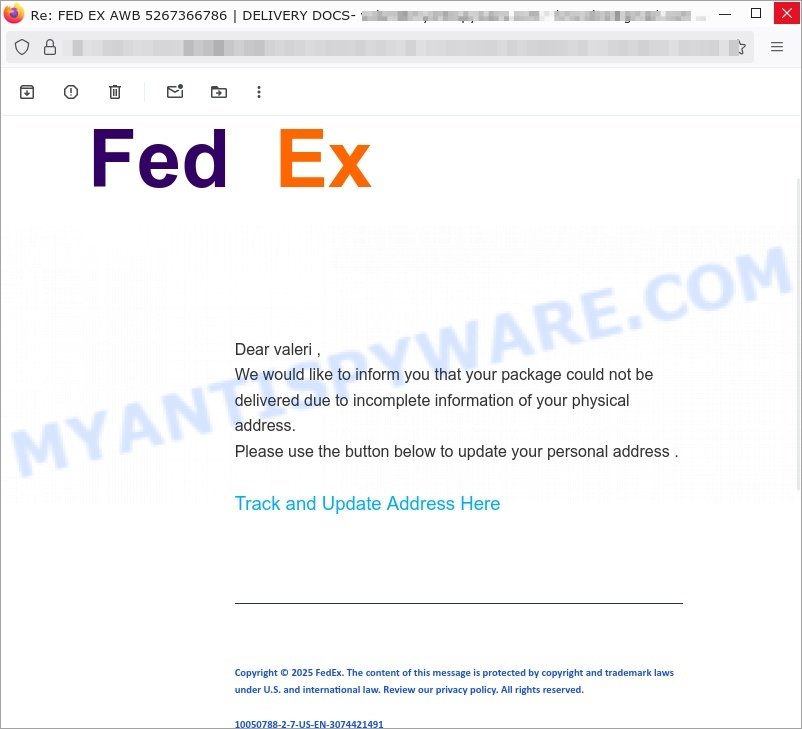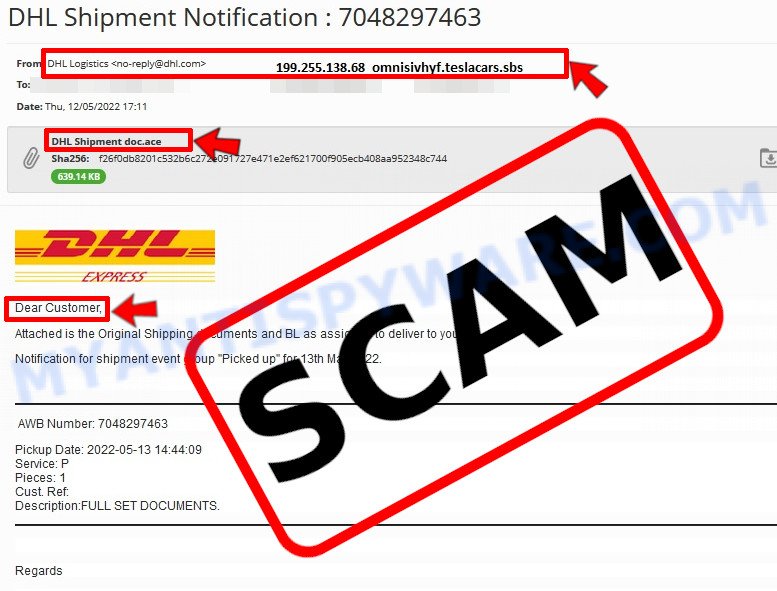Have you come across an email saying “Your package could not be delivered” with the subject “Re: FED EX AWB | DELIVERY DOCS” offering you to update your address by clicking on a link?

Question: Is this email legitimate and from FedEx, and should you click the link to update your address?
Investigation Findings: The email is a scam, designed to steal your personal information. The link leads to a phishing website, easy-gabby-taleggio.glitch.me, which tries to mimic a real site but aims to trick you into entering sensitive data.
Answer: The FedEx “Your package could not be delivered” email is a fraudulent attempt to steal your personal information through phishing. 💡 To protect yourself from scams like this, always check the sender’s email address and be wary of unfamiliar addresses. Additionally, never click on links in unsolicited emails. Always go directly to the official FedEx website or contact their customer support if in doubt.
A typical “FedEx Your package could not be delivered” scam email reads as follows:
Subject: Re: FED EX AWB 5267366786 | DELIVERY DOCS- xxxxxxx
From: FED EXFed Ex
Dear xxxxx ,
We would like to inform you that your package could not be delivered due to incomplete information of your physical address.
Please use the button below to update your personal address .Track and Update Address Here
Copyright © 2025 FedEx. The content of this message is protected by copyright and trademark laws under U.S. and international law. Review our privacy policy. All rights reserved.
10050788-2-7-US-EN-3074421491
The FedEx delivery scam is a common trick targeting many email users. This scam pretends to come from FedEx and claims there’s an issue with delivering your package because your address is incomplete. The email encourages you to click on a link to update your address information.
This email scam is designed to steal sensitive information. When you click the link labeled “Track and Update Address Here”, it takes you to a fake webpage made to look real, but in fact, it’s controlled by scammers. Their goal is to get things like your personal details, address, and sometimes even payment information.
These fake emails often have telltale signs. The sender’s email address, like “info@chinasafteyfence.com”, looks suspicious and not related to FedEx. Always be cautious with any unexpected emails asking for your personal or financial information.
💡 If you receive such an email, don’t click on any links. Mark the email as spam and delete it right away to protect your information. To double-check package deliveries, you can directly visit the official FedEx website by typing the URL into your web browser or using their official app.
Summary Table
| Name | FedEx Delivery Scam |
| Type | Email Phishing |
| Fake Sender | FED EX <info@chinasafteyfence.com> |
| Fake Link | easy-gabby-taleggio.glitch[.]me |
| Target | Personal Information |
📧 What to Do When You Receive the “FedEx Your package could not be delivered” Scam Email
We advise everyone who receives this email to follow the simple steps below to protect yourself from potential scams:
- ❌ Do not believe this email.
- 🔒 NEVER share your personal information and login credentials.
- 📎 Do not open unverified email attachments.
- 🚫 If there’s a link in the scam email, do not click it.
- 🔍 Do not enter your login credentials before examining the URL.
- 📣 Report the scam email to the FTC at www.ftc.gov.
If you accidentally click a phishing link or button in the “FedEx Your package could not be delivered” Email, suspect that your computer is infected with malware, or simply want to scan your computer for threats, use one of the free malware removal tools. Additionally, consider taking the following steps:
- 🔑 Change your passwords: Update passwords for your email, banking, and other important accounts.
- 🛡️ Enable two-factor authentication (2FA): Add an extra layer of security to your accounts.
- 📞 Contact your financial institutions: Inform them of any suspicious activity.
- 🔄 Monitor your accounts: Keep an eye on your bank statements and credit reports for any unusual activity.
🔍 How to Spot a Phishing Email
Phishing emails often share common characteristics; they are designed to trick victims into clicking on a phishing link or opening a malicious attachment. By recognizing these signs, you can detect phishing emails and prevent identity theft:

💡 Here Are Some Ways to Recognize a Phishing Email
- ✉️ Inconsistencies in Email Addresses: The most obvious way to spot a scam email is by finding inconsistencies in email addresses and domain names. If the email claims to be from a reputable company, like Amazon or PayPal, but is sent from a public email domain such as “gmail.com”, it’s probably a scam.
- 🔠 Misspelled Domain Names: Look carefully for any subtle misspellings in the domain name, such as “arnazon.com” where the “m” is replaced by “rn,” or “paypa1.com,” where the “l” is replaced by “1.” These are common tricks used by scammers.
- 👋 Generic Greetings: If the email starts with a generic “Dear Customer”, “Dear Sir”, or “Dear Madam”, it may not be from your actual shopping site or bank.
- 🔗 Suspicious Links: If you suspect an email may be a scam, do not click on any links. Instead, hover over the link without clicking to see the actual URL in a small popup. This works for both image links and text links.
- 📎 Unexpected Attachments: Email attachments should always be verified before opening. Scan any attachments for viruses, especially if they have unfamiliar extensions or are commonly associated with malware (e.g., .zip, .exe, .scr).
- ⏰ Sense of Urgency: Creating a false sense of urgency is a common tactic in phishing emails. Be wary of emails that claim you must act immediately by calling, opening an attachment, or clicking a link.
- 📝 Spelling and Grammar Errors: Many phishing emails contain spelling mistakes or grammatical errors. Professional companies usually proofread their communications carefully.
- 🔒 Requests for Sensitive Information: Legitimate organizations typically do not ask for sensitive information (like passwords or Social Security numbers) via email.
✅ Conclusion
We hope this article has helped you understand more about the “FedEx Your package could not be delivered” Scam Email and how to avoid falling victim to scammers. If you have received a phishing email that is similar but not identical to the example above, please post it in the comments section of this article. This helps us warn other users about potential scams and improve our resources to protect you better. Stay safe and vigilant! 🛡️














